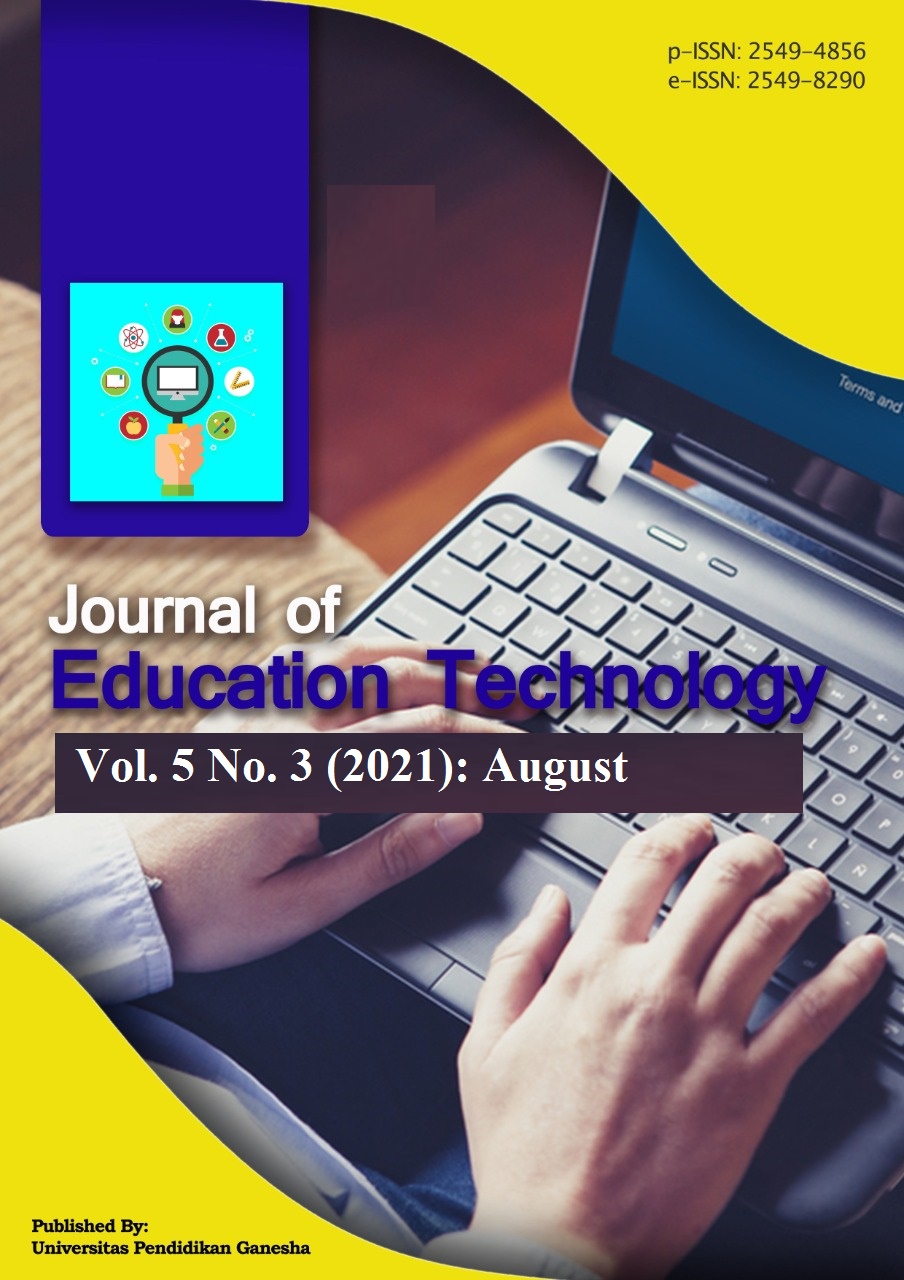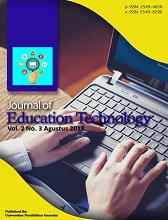Development of E-Comic Learning Media on the Topic of the Human Digestive System
DOI:
https://doi.org/10.23887/jet.v5i3.34732Keywords:
Media, e-comic, digestive systemAbstract
Learning during a pandemic make teachers have to change learning that is usually carried out face-to-face into online learning that is still fun for students. Learning media during online learning will help teachers deliver learning material more creatively to become more enjoyable, and students easily understand the learning material. This study aims to develop e-comic learning media on the topic of the human digestive system. This research is a type of development research using the ADDIE model. However, this study's implementation and evaluation stages cannot be carried out due to the COVID-19 pandemic, limited time, resources, and costs. Thus, in this study, only the analysis, design, and development stages were carried out. The subjects in this study were two media experts, two material experts, and two practitioners. The data collected in this study used a questionnaire method by analyzing the e-comic learning media. The data from the validation results from the experts were then analyzed using the mean formula to find out the average validity score of e-comic learning media on the topic of the human digestive system. The analysis results show that the average validation score of e-comic learning media on the topic of the human digestive system is 4.65 with very good qualifications, and material validation is 4.57 with very good qualifications. So, e-comic learning media on the topic of the human digestive system are declared valid and have very good qualifications.
References
Aggleton, J. (2019). Defining digital comics: a British Library perspective. Journal of Graphic Novels and Comics, 10(4), 393–409. https://doi.org/10.1080/21504857.2018.1503189
Amalia, R. U., Isnaeni, B., & Hanafi, Y. (2020). Analisis kendala peserta didik dalam pembelajaran online materi biologi di Smp Negeri 3 Bantul. Bio Education, 5(2), 10–15. http://www.jurnal.unma.ac.id/index.php/BE/article/view/2422/2043
Arsyad, A. (2017). Media Pembelajaran. Rajawali Pers.
Azubuike, O. B., Adegboye, O., & Quadri, H. (2021). Who gets to learn in a pandemic? Exploring the digital divide in remote learning during the COVID-19 pandemic in Nigeria. International Journal of Educational Research Open, 2–2. https://doi.org/10.1016/j.ijedro.2020.100022
Baber, H. (2021). Modeling the acceptance of e-learning during the pandemic of COVID-19-A study of South Korea. The International Journal of Management Education, 19(2), 100503. https://doi.org/10.1016/j.ijme.2021.100503
Budiyono, B. (2020). Inovasi Pemanfaatan Teknologi Sebagai Media Pembelajaran di Era Revolusi 4.0. Jurnal Kependidikan: Jurnal Hasil Penelitian Dan Kajian Kepustakaan Di Bidang Pendidikan, Pengajaran Dan Pembelajaran, 6(2), 300. https://doi.org/10.33394/jk.v6i2.2475
Busyaeri, A., Udin, T., & Zaenudin, A. (2016). Pengaruh Penggunaan Video Pembelajaran Terhadap Peningkatan Hasil Belajar Mapel Ipa Di Min Kroya Cirebon. Al Ibtida: Jurnal Pendidikan Guru MI, 3(1), 116–137. https://doi.org/10.24235/al.ibtida.snj.v3i1.584
Dwiasih, A. A. I., & Agung, A. A. G. (2021). The Development of Fabel E-Comic in Bahasa Indonesia Lesson for Grade II of Elementary School. https://doi.org/10.2991/assehr.k.210407.284
Enteria, O., & Casumpang, P. F. H. (2019). Effectiveness of Developed Comic Strips as Instructional Materials in Teaching Specific Science Concepts. International Journal for Innovation Education and Research, 7(10), 876–882. https://doi.org/10.31686/ijier.vol7.iss10.1835
Eva, R., Sumantri, M. S., & Winarsih, M. (2020). Media Pembelajaran Abad 21: Komik Digital Untuk Siswa Sekolah Dasar. Prosiding Seminar Dan …. http://journal.unj.ac.id/unj/index.php/psdpd/article/view/17744
Ghasem, N., & Ghannam, M. (2021). Challenges, benefits & drawbacks of chemical engineering online teaching during Covid-19 pandemic. Education for Chemical Engineers, 36, 107–114. https://doi.org/10.1016/j.ece.2021.04.002
Guan, W., Ni, Z., Hu, Y., Liang, W., Ou, C., He, J., Liu, L., Shan, H., Lei, C., Hui, D. S. C., Du, B., Li, L., Zeng, G., Yuen, K.-Y., Chen, R., Tang, C., Wang, T., Chen, P., Xiang, J., … Zhong, N. (2020). Clinical Characteristics of Coronavirus Disease 2019 in China. New England Journal of Medicine, 382(18), 1708–1720. https://doi.org/10.1056/NEJMoa2002032
Hincal, E., & Alsaadi, S. H. (2021). Stability analysis of fractional order model on corona transmission dynamics. Chaos, Solitons & Fractals, 143, 110628. https://doi.org/10.1016/j.chaos.2020.110628
Hobri, Murtikusuma, R. P., & Hermawan, L. I. (2019). Development of e-comic using pixton and kelase web on linear program of two variables assisted by geogebra. Journal of Physics: Conference Series, 1265, 012010. https://doi.org/10.1088/1742-6596/1265/1/012010
Hong, J.-C., Lee, Y.-F., & Ye, J.-H. (2021). Procrastination predicts online self-regulated learning and online learning ineffectiveness during the coronavirus lockdown. Personality and Individual Differences, 174, 110673. https://doi.org/10.1016/j.paid.2021.110673
Isya’, M. A. (2017). Pengembangan model pembelajaran instruksional design dengan model Addie mata pelajaran PAI pada materi mengulang-ulang hafalan Surah Al Ma’un dan al Fil secara klasikal, kelompok dan individu kelas V SDN Gedongan 2 Kota Mojokerto. Ta’dibia: Jurnal Ilmiah Pendidikan Agama Islam, 7(1), 71. https://doi.org/10.32616/tdb.v7.1.37.71-80
Jogezai, N. A., Baloch, F. A., Jaffar, M., Shah, T., Khilji, G. K., & Bashir, S. (2021). Teachers’ attitudes towards social media (SM) use in online learning amid the COVID-19 pandemic: the effects of SM use by teachers and religious scholars during physical distancing. Heliyon, 7(4), e06781. https://doi.org/10.1016/j.heliyon.2021.e06781
Maula, N. R., & Fatmawati, L. (2020). Pengembangan Media Pembelajaran Kayaku (Kayanya Alam Negeriku) Berbasis STEM Kelas IV Sekolah Dasar. Jurnal Ilmiah Sekolah Dasar, 4(1), 97. https://doi.org/10.23887/jisd.v4i1.22351
Mishra, L., Gupta, T., & Shree, A. (2020). Online teaching-learning in higher education during lockdown period of COVID-19 pandemic. International Journal of Educational Research Open, 1, 100012. https://doi.org/10.1016/j.ijedro.2020.100012
Ntobuo, N. E., Arbie, A., & Amali, L. N. (2018). The Development of Gravity Comic Learning Media Based on Gorontalo Culture. Jurnal Pendidikan IPA Indonesia, 7(2), 246–251. https://doi.org/10.15294/jpii.v7i2.14344
Nurdin, E., Ma’aruf, A., Amir, Z., Risnawati, R., Noviarni, N., & Azmi, M. P. (2019). Pemanfaatan video pembelajaran berbasis Geogebra untuk meningkatkan kemampuan pemahaman konsep matematis siswa SMK. Jurnal Riset Pendidikan Matematika, 6(1), 87–98. https://doi.org/10.21831/jrpm.v6i1.18421
Rafique, G. M., Mahmood, K., Warraich, N. F., & Rehman, S. U. (2021). Readiness for Online Learning during COVID-19 pandemic: A survey of Pakistani LIS students. The Journal of Academic Librarianship, 47(3), 102346. https://doi.org/10.1016/j.acalib.2021.102346
Rahmata, A., Tuljannah, L., Chotimah, S. C., & Fiangga, S. (2020). Validitas E-Comic Matematika Berbasis Pemecahan Masalah pada Materi Kesebangunan. Jurnal Review Pembelajaran Matematika, 5(1), 53–65. https://doi.org/10.15642/jrpm.2020.5.1.53-65
Riwanto, M. A., & Wulandari, M. P. (2018). Efektivitas Penggunaan Media Komik Digital (Cartoon Story Maker) dalam Pembelajaran Tema Selalu Berhemat Energi. Pancar, 2(1), 14–18. https://ejournal.unugha.ac.id/index.php/pancar/article/viewFile/195/160
Shah, K., Arfan, M., Mahariq, I., Ahmadian, A., Salahshour, S., & Ferrara, M. (2020). Fractal-Fractional Mathematical Model Addressing the Situation of Corona Virus in Pakistan. Results in Physics, 19, 103560. https://doi.org/10.1016/j.rinp.2020.103560
Shah, S. S., Shah, A. A., Memon, F., Kemal, A. A., & Soomro, A. (2021). Aprendizaje en línea durante la pandemia de COVID-19: aplicación de la teoría de la autodeterminación en la “nueva normalidad.” Revista de Psicodidáctica. https://doi.org/10.1016/j.psicod.2020.12.004
Singhal, T. (2020). A Review of Coronavirus Disease-2019 (COVID-19). The Indian Journal of Pediatrics, 87(4), 281–286. https://doi.org/10.1007/s12098-020-03263-6
Sukmanasa, E., Windiyani, T., & Novita, L. (2017). Pengembangan Media Pembelajaran Komik Digital Pada Mata Pelajaran Ilmu Pengetahuan Sosial Bagi Siswa Kelas V Sekolah Dasar Di Kota Bogor. Jurnal Pendidikan Sekolah Dasar, 3(2), 171. https://doi.org/10.30870/jpsd.v3i2.2138
Summak, M. S., Bağlıbel, M., & Samancıoğlu, M. (2010). Technology readiness of primary school teachers: A case study in Turkey. Procedia - Social and Behavioral Sciences, 2(2), 2671–2675. https://doi.org/10.1016/j.sbspro.2010.03.393
Tang, Y. M., Chen, P. C., Law, K. M. Y., Wu, C. H., Lau, Y., Guan, J., He, D., & Ho, G. T. S. (2021). Comparative analysis of student’s live online learning readiness during the coronavirus (COVID-19) pandemic in the higher education sector. Computers & Education, 168, 104211. https://doi.org/10.1016/j.compedu.2021.104211
Taufiq, M., Wijayanti, A., & Fajriah, E. (2020). The implementation of e-comic earth layer to enhance students’ self-directed learning. Journal of Physics: Conference Series, 1567, 022070. https://doi.org/10.1088/1742-6596/1567/2/022070
Yektyastuti, R., & Ikhsan, J. (2016). Pengembangan media pembelajaran berbasis android pada materi kelarutan untuk meningkatkan performa akademik siswa SMA. Jurnal Inovasi Pendidikan IPA, 2(1), 88. https://doi.org/10.21831/jipi.v2i1.10289
Downloads
Published
How to Cite
Issue
Section
License
Authors who publish with the Journal of Education Technology agree to the following terms:
- Authors retain copyright and grant the journal the right of first publication with the work simultaneously licensed under a Creative Commons Attribution License (CC BY-SA 4.0) that allows others to share the work with an acknowledgment of the work's authorship and initial publication in this journal.
- Authors are able to enter into separate, additional contractual arrangements for the non-exclusive distribution of the journal's published version of the work (e.g., post it to an institutional repository or publish it in a book), with an acknowledgment of its initial publication in this journal.
- Authors are permitted and encouraged to post their work online (e.g., in institutional repositories or on their website) prior to and during the submission process, as it can lead to productive exchanges, as well as earlier and greater citation of published work. (See The Effect of Open Access)















